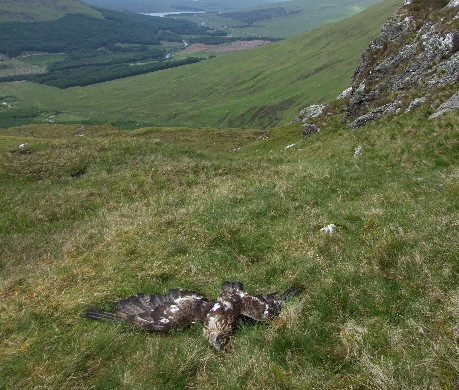Monday 20th February 2017, 11:17am
Walkers and climbers out in the countryside are being asked to report any dead birds of prey they may come across to Police Scotland. The call comes as part of a campaign, by the Partnership for Action against Wildlife Crime (PAW) Scotland, to counter raptor persecution.
Birds of prey are widespread over Scotland's varied landscape. In general, golden eagles favour remote, mountainous regions while buzzards, red kites and peregrine falcons prefer lower wooded ground or cliff faces.
A Scottish Government study indicates that the public are covering large areas of the countryside. The report, “Let's Get Scotland Walking: The National Walking Strategy" (published in 2014) shows that, in 2012, visitors took 2.2 million walks (of up to two miles or up to one hour) and 1.8 million long walks (more than two miles or more than one hour) in Scotland.
This makes the walking community, from the adventurous hill walker down to the weekend family stroller, a valuable resource as "eyes on the ground,” in tackling wildlife crime. It also means that walkers are getting to places which criminals think are out of sight.
In 2012, a farm manager was convicted for possession of illegal pesticide and fined £1,200 following the discovery by hill walkers of an unlawfully poisoned golden eagle near Bridge of Orchy. Whilst in 2015, walkers came across a gamekeeper stoning and repeatedly stamping on a buzzard near Dumfries. Following a report to Police Scotland this resulted in the individual being convicted of illegally killing and possessing the bird, and receiving a cumulative fine of £2,000. Many more reports have resulted in police investigations although, on occasion, there has been insufficient evidence to secure a conviction in court.
But it’s still vital to report dead birds as it helps scientists see if other things are killing them.
Over the last two years, more than 200 carcasses have been submitted to Science & Advice for Scottish Agriculture (SASA) for post-mortem to establish cause of death. Less than 10 per cent can be unequivocally attributed to wildlife crime. But the carcasses are still of use in wider conservation research to assess the impact of legal pesticides on raptors and assess their general health in the wild.
Gabriela Peniche, who through the University of Edinburgh’s Royal (Dick) School of Veterinary Studies, leads research into the health of birds of prey, is grateful for the reporting and receiving of all carcasses. She said: "Without the help of people finding and recovering dead birds in the countryside, my work would be significantly harder. The more carcasses we recover, the greater the understanding we have on the overall health of our wild raptors.” The project continues until October 2019.
Constable Charles Everitt, a Police Scotland officer seconded to the UK National Wildlife Crime Unit, and a member of PAW Scotland, said: “The valuable role played by people walking in the countryside - be it on the mountain tops or through lower wooded and rural land – can’t be underestimated.
“Without their help in alerting the police to dead birds of prey, we simply would not know about it. Once reported to the police, officers can assess the information, recover the bird if appropriate and investigate any criminality.
“Regardless of the outcome of the investigation, conservation itself benefits from the research opportunities afforded, by being able to post-mortem the carcass. Leisure and recreational walkers - including hill walkers, mountaineers, rambling groups or families simply out for a stroll - often enter the countryside to enjoy a different and altogether wilder environment. This includes the wildlife contained within that landscape, so walkers are well placed to contribute to the overall well-being of our raptor population."
When a dead bird of prey is found, don’t touch it but call Police Scotland on 101 and be guided by them. In general, photographs should be taken, a note of the location (grid reference if possible) and the carcass covered with vegetation to make it safe.
Never approach suspects, who may be dangerous and possibly armed. In an emergency - when a life is in danger, a crime is in progress or a suspect is still on the scene – always dial 999.
Further advice can be found on the Partnership for Action Against Wildlife Crime in Scotland (PAW Scotland) website

Dead Golden Eagle near Bridge of Orchy. Photo courtesy of RSPB.